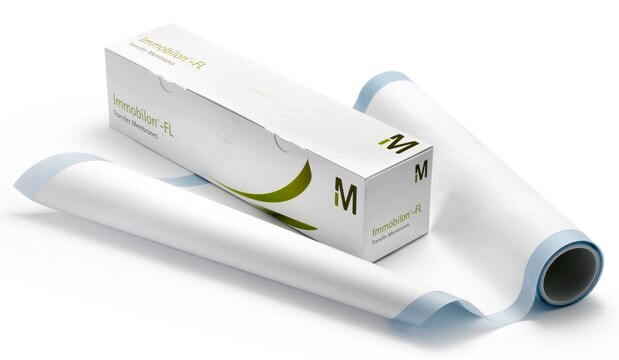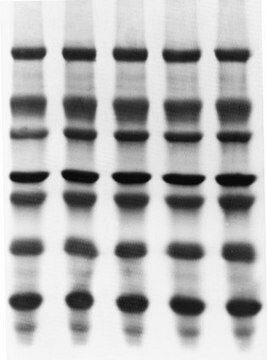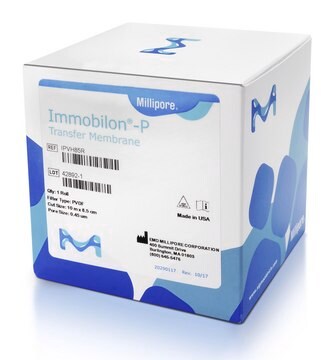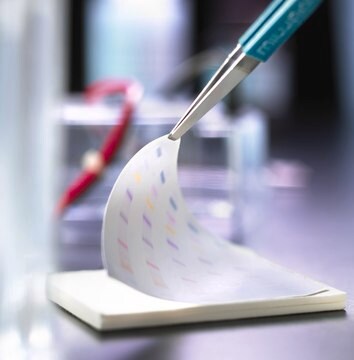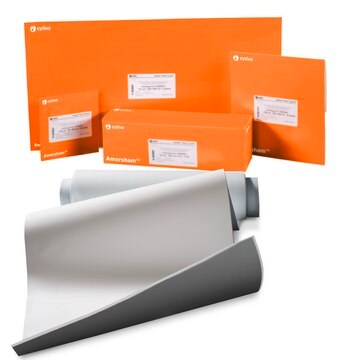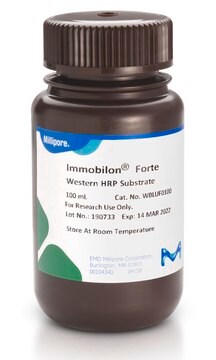IPVH00010
Immobilon® -P PVDF Membrane
1 roll, 27 cm x 3.75 m, 0.45 µm pore size, transfer membrane
Synonim(y):
Western blotting membrane, blotting membrane, transfer membrane
About This Item
Polecane produkty
product name
Immobilon®-P PVDF Membrane, 1 roll, 27 cm x 3.75 m, 0.45 µm pore size, Hydrophobic PVDF Transfer Membrane for western blotting.
Materiały
PVDF membrane
plain filter
white filter
Poziom jakości
Właściwości
hydrophobic
producent / nazwa handlowa
Immobilon®
metody
dot blot: suitable
western blot: suitable
filtr dł. × szer.
27 cm × 3.75 m
wielkość porów
0.45 μm pore size
pojemność
160 μg/cm2 adsorption capacity (insulin)
215 μg/cm2 adsorption capacity (BSA)
294 μg/cm2 adsorption capacity (goat IgG)
kompatybilność
for use with Amido black
for use with CPTS
for use with Colloidal gold
for use with Coomassie brilliant blue
for use with India ink
for use with Ponceau-S red
for use with Sypro<TMSYMBOL></TMSYMBOL> ruby
for use with Toluidine blue
for use with Transillumination
metoda wykrywania
chemiluminescent
colorimetric
fluorometric
radioactive
Warunki transportu
ambient
Opis ogólny
Cechy i korzyści
- Won′t crack, curl or fracture when cut
- Low background
- Superior staining capabilities
- Can be reprobed multiple times
Powiązanie
Inne uwagi
Informacje prawne
Kod klasy składowania
11 - Combustible Solids
Klasa zagrożenia wodnego (WGK)
WGK 3
Temperatura zapłonu (°F)
Not applicable
Temperatura zapłonu (°C)
Not applicable
Certyfikaty analizy (CoA)
Poszukaj Certyfikaty analizy (CoA), wpisując numer partii/serii produktów. Numery serii i partii można znaleźć na etykiecie produktu po słowach „seria” lub „partia”.
Masz już ten produkt?
Dokumenty związane z niedawno zakupionymi produktami zostały zamieszczone w Bibliotece dokumentów.
Klienci oglądali również te produkty
Produkty
Comparison of elution techniques for small-scale protein purification of FLAG® tag proteins using anti-FLAG® M2 magnetic beads.
Porównanie technik elucji do oczyszczania białek FLAG® na małą skalę przy użyciu kulek magnetycznych anty-FLAG® M2.
Protokoły
This page shows and discusses three protocols for stripping and reprobing a western blot membrane.
Na tej stronie przedstawiono i omówiono trzy protokoły usuwania i reprobingu błony western blot.
Protokół przygotowania próbki do lizy komórek i wydajnej ekstrakcji białek z hodowanych tkanek i komórek do późniejszego Western blottingu.
Nasz zespół naukowców ma doświadczenie we wszystkich obszarach badań, w tym w naukach przyrodniczych, materiałoznawstwie, syntezie chemicznej, chromatografii, analityce i wielu innych dziedzinach.
Skontaktuj się z zespołem ds. pomocy technicznej